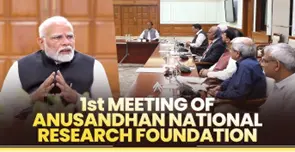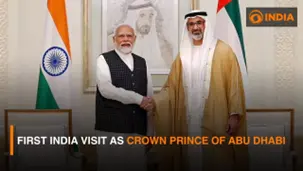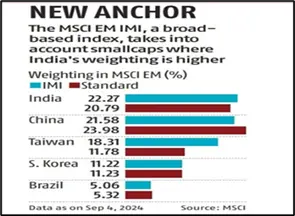Thursday, 12th September 2024
Indo-Pacific Oceans Initiative (IPOI)
Why in the news?
- Recently, the Indo-Pacific Oceans Initiative (IPOI) completes five years since its launch in 2019 at the East Asia Summit (EAS) in Bangkok (Thailand) as an open, inclusive, non treaty-based global initiative.

- Objective:
- Its objective was to promote cooperation for a free and open Indo-Pacific and the rules-based regional order, which will contribute towards strengthening safety, stability and development in the maritime domain.
- Philosophy:
- Builds upon India’s ‘Security and Growth for All in the Region (SAGAR)’ initiative of 2015.
- IPOI seeks to build a sense of community by creating new partnerships with like-minded countries through practical cooperation.
- No institutional framework:
- It does not envisage a new institutional framework and leans heavily on the EAS mechanism, which includes ASEAN member states and its eight dialogue partners.
Key Pillars and Leadership of IPOI:

Significance of IPOI:
- The Indo-Pacific Oceans Initiative (IPOI) aims to uphold a rules-based regional order, promoting free movement of goods, services, and people while respecting national sovereignty.
- It aligns with India’s Maritime India Vision 2030 and Maritime Amrit Kaal Vision 2047 and converges with global initiatives like AIIPOIP, AOIP, and IPEF.
- IPOI enhances regional maritime security by fostering cooperation to address piracy, illegal fishing, and other maritime threats.
Way Ahead:
- Vision and broad agenda: Discussions, dialogue, conferences and workshops on IPOI have been held with multi stakeholder participation across the region and the next five years should be outlined by leaders of each pillar after due consultation.
- Pillar-specific dialogues: These can be in coordination with the EAS, East Asia Maritime Forum (EAMF), Indian Ocean Rim Association (IORA), and other regional frameworks dealing specifically with each of the pillars.
- Participation of East Africa, GCC countries and small island states: Partly due to its genesis under India’s Act East policy and the linkage with the EAS mechanism, East African and GCC countries, and small island states are not duly represented in the framework.
- Periodic dissemination: Such dissemination would also show the usefulness of regional maritime cooperation in its broadest sense, which in turn would encourage other countries from or outside the region to participate.
Source: ORF
Mission Mausam
Why in the news?
- Recently, The Union Cabinet has approved ‘Mission Mausam’ with a budget of ₹2,000 crore over two years.
- Objectives of Mission Mausam:
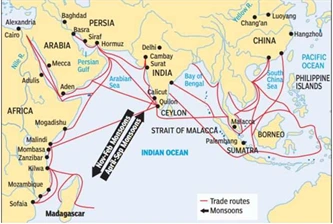
-
- Improving Weather Prediction: Accuracy by utilizing advanced technologies, Mission Mausam aims to provide highly accurate and timely weather and climate forecasts.
- Strengthening Climate Resilience: The mission will equip various stakeholders, including citizens and last-mile users, to better tackle extreme weather events and the impacts of climate change.
- Broadening Capacity in Weather Sciences: Through research and development, the mission will strengthen India's capability in atmospheric sciences, including weather modeling, forecasting, and surveillance.
- Key Focus Areas:
- Monsoon Forecasts for agriculture and water management.
- Air Quality Alerts and manage pollution
- Extreme Weather Events like timely alerts for cyclones and floods.
- Weather Interventions: Techniques for managing fog, hail, and rain to minimize disruptions in daily life and business activities.
- Technological Advancements Under Mission Mausam:
- Advanced surveillance systems: The mission will use next-generation radar, satellite systems and sensors to capture real-time data.
- Computer efficiency: Supercomputers will be added to the system to efficiently process large amounts of data.
- Artificial Intelligence (AI) and Machine Learning (ML): AI and ML technologies will be used for accurate weather forecasting.
- Land system modeling: Comprehensive modeling will help predict a variety of weather conditions including rainy season models, storms and extreme weather
- GIS-based automated decision support system: This system provides real-time data distribution and alerting.
- Sectors Benefiting from Mission Mausam:
- Agriculture: Accurate weather forecasts will help farmers plan crop cycles and reduce losses due to unpredictable weather.
- Disaster Management: Early warnings and accurate predictions will enhance disaster preparedness and reduce the impact of natural calamities.
- Defence and Aviation: Real-time weather data will support operations in defense and aviation by ensuring safer travel and military operations.
- Environment and Health: Better environmental monitoring will contribute to sustainable development, while improved air quality forecasts will protect public health.
- Transport and Energy: Weather forecasts will aid urban planning, road transport, offshore operations, and energy production, especially in renewable sectors like wind and solar power.
- Implementing Institutions:
- The India Meteorological Department (IMD)
- The Indian Institute of Tropical Meteorology (IITM)
- The National Centre for Medium-Range Weather Forecasting (NCMRWF)
|
UPSC Civil Services Examination PYQ Mains Q:1 Discuss the meaning of color-coded weather warnings for cyclone prone areas given by India Meteorological Department. (2022) |
Source: IE
Centre relaxes norms under PMAY-Gramin
Why in the news?
- Recently, The Centre has relaxed the automatic exclusion criteria for the Pradhan Mantri Awas Yojana-Gramin (PMAY-G), allowing families with certain assets to avail of the rural housing scheme.
About Pradhan Mantri Awas Yojana-Rural (PMAY-G):
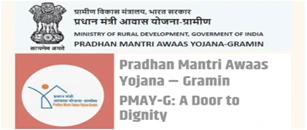
- Objective: To provide pukka houses with basic facilities for rural families who are homeless or living in kutcha or dilapidated houses.
- Beneficiaries:
- Identified by Socio-Economic Caste Census (SECC) 2011 .
- The core functions of the Ministry of Rural Development (MoRD) are implemented by the Ministry of Housing and Urban Affairs (MoHUA).
- Cost Sharing:
- 60:40 ratio between Center and States for common destinations.
- The ratio is 90:10 for North Eastern States, Himalayan States and Jammu Chamber.
- For other UTs, the Center incurred 100 per cent of the cost.
- The scheme aims to provide assistance for construction of 2.95 crore pucca houses for eligible rural households by March, 2022 in phases:
- 1 crore houses in Phase I (2016-17 to 2018-19).
- 1.95 crore houses in Phase II (2019-20 to 2021-22).
- features:
- Financial Assistance:
- The unit assistance is Rs1.20 lakh in plains and Rs. 1.30 lakh in hilly states, difficult areas and IAP districts.
- Along with financial assistance, the beneficiary is also offered 90 days of employment under the MGNREGA (approximately Rs 18000).
- Another Rs 12000 will be offered to construct toilets.
- Automatic Inclusion:
- The Criteria for Automatic Inclusion as follows
- Households without shelter
- Destitute / living on alms
- Manual scavengers
- Primitive tribal groups
- Legally released bonded laborer
- Convergence with other schemes:
- Construction of toilets and wage works encourage synergies with schemes like Swachh Bharat Mission (SBM) and MGNREGA.
- Financial Assistance:
- Some exclusions remain:
- Owning motorized three/four-wheelers,
- Mechanized agricultural equipment,
- Having a Kisan Credit Card with a limit above Rs 50,000,
- Government employment,
- Registered non-agricultural businesses, and
- Tax paying households.
|
UPSC Civil Services Examination, Previous Year Question (PYQ) Mains: Q:1 With a brief background of quality of urban life in India, introduce the objectives and strategy of the ‘Smart City Programme.” (2016) Q:2 Discuss the various social problems which originated out of the speedy process of urbanization in India. (2013) |
Source: IE
5 Years of Pradhan Mantri Kisan Maandhan Yojana
Why in the news?
- Recently, the Pradhan Mantri Kisan Maandhan Yojana (PM-KMY), Completed five successful years, launched on 12th September 2019.
Successful Implementation of PM-KMY:
- Farmers aged between 18 and 40 years need to contribute between Rs. 55 to Rs. 200 per month until they turn 60.
- Once they reach the age of 60, enrolled farmers receive a monthly pension of Rs. 3,000, provided they meet the scheme's exclusion criteria.
- The Life Insurance Corporation (LIC) manages the pension fund, and beneficiary registration is facilitated through Common Service Centres (CSCs) and State Governments.
- All farmers with cultivable land holdings of up to 2 hectares and listed in state/UT land records as of 1st August 2019 are eligible for benefits under the scheme.
- As of August 6, 2024, a total of 23.38 lakh farmers have joined the scheme.
- Under the scheme, Bihar leads with over 3.4 lakh registrations while Jharkhand ranks second with over 2.5 lakh registrations.
- Further, Uttar Pradesh, Chhattisgarh, and Odisha have over 2.5 lakh, 2 lakh, and 1.5 lakh farmer registrations, respectively.
Key Benefits Under PM-KMY:
- Minimum Assured Pension: Each subscriber to the scheme is guaranteed a minimum pension of Rs. 3000 per month upon reaching the age of 60 years
- Family Pension:
- If a subscriber passes away while receiving their pension, their spouse will be entitled to a family pension equal to 50% of the amount the subscriber was receiving i.e. Rs.1500 per month as Family Pension.
- This is only applicable if the spouse is not already a beneficiary of the scheme. The family pension benefit is exclusively for the spouse.
- PM-KISANBenefit:Forthis,eligible SMFs must sign and submit an enrolment-cum-auto-debit-mandate form and contributions from the bank account where their PM-KISAN benefits are credited.
- Equal Contribution by Government: The Central Government, through the Department of Agriculture Cooperation and Farmers Welfare, also contributes an equal amount as contributed by the eligible subscriber, to the pension Fund
- Monthly Contributions: Monthly contributions are in the range from Rs. 55 to Rs. 200, based on the farmer's age at the time of entry into the Scheme, according to the contribution chart.
Leaving the Pension Scheme:
Conclusion
Over five years of implementation, the PM-KMY key achievements of PM-KMY is its role in providing financial stability to farmers, many of whom face uncertain futures due to the seasonal nature of agriculture and fluctuating incomes. Its success over the past five years underscores its critical role in enhancing one of the country’s ‘Annadata’ quality of life.
|
UPSC Civil Services Examination, Previous Year Question (PYQ) Prelims Q:1 Under the Kisan Credit Card scheme, short-term credit support is given to farmers for which of the following purposes? (2020)
Select the correct answer using the code given below:
Ans: (b)
Q:2 In India, which of the following can be considered as public investment in agriculture? (2020)
Select the correct answer using the code given below:
Ans: (c)
Mains Q:1 What do you mean by Minimum Support Price (MSP)? How will MSP rescue the farmers from the low-income trap? (2018) |
Source: PIB
Elongated tortoise
Why in the news ?
- Recently, An elongated tortoise was spotted in Haryana.
- About: The Elongated, or Yellow-headed, Tortoise is a medium-sized tortoise.
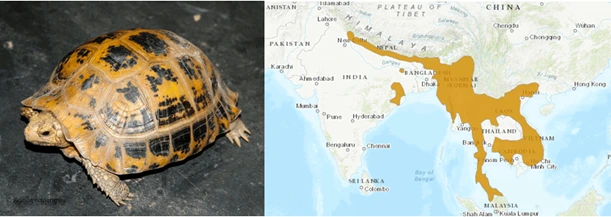
- Distribution: Southeast Asia, particularly Northeast India. A disjunct population exists in the Chota Nagpur plateau.
- Habitat: Sal deciduous and hilly evergreen forests and It is sexually dimorphic.
- Physical description: Medium-sized with a yellowish brown or olive shell and distinct black blotches at the center of each scute. The tortoise has on its nostril a pink ring, which appears in the breeding season.
- Diet: They are omnivores feeding on plants, fallen fruits, flowers, fungi, snails, slugs, and carrion.
- Conservation Status: IUCN: Critically endangered
- Threats: Exploited for food and traditional medicine, habitat destruction, fragmentation, and loss.
Source: (IE)
'Blueprint' for AI use in military
Why in the news ?
- Recently, The REAIM (Responsible AI in the Military) Conference in Seoul (South Korea) presented a binding non-binding "action plan" to guide the responsible use of AI in the military from the 1990s onwards the year 2024 was given
- With the first meeting scheduled for 2023, REAIM is a forum for global discussion with all stakeholders on ways to ensure the responsible use of AI by the military
Highlights of the ‘action plan’:

- Impact of AI on International Peace and Security:
- AI applications in the military should be designed, implemented and operated in a way that promotes international peace and security and stability, not that it will be destroyed
- The use of Al may pose predictable and unforeseen risks, including arms races, miscalculations, increased conflict, and decreased conflict
- It emphasizes in all necessary actions in sovereign decisions regarding the notification and management of nuclear weapons, without achieving the goal of a world without nuclear weapons the main goal is not destroyed.
- Responsible use of AI in the military:
- The use of AI should be ethical and humane, implemented in accordance with applicable national and international regulations, encourage experimental dialogue and encourage research den (T&E) comprehensive programs.
- Future governance of AI in the military:
- Governance must be open and inclusive to fully reflect the broader perspective, strengthen international cooperation in capacity building, and reduce knowledge as there are differences in accountability and performance.
Source: RT
Standing Committee on Statistics (SCoS)
Why in the news:
- On September 11, 2024, the Standing Committee on Statistics formed to oversee all statistical surveys by the Ministry of Statistics and Programme Implementation (MoSPI) was dissolved by the government amid apparent concerns raised by some members over the delay in conducting the census.
About the Standing Committee on Audit (SCoS):
- Established:
- It was established in 2019 as an earlier version of the former Committee on Economic Statistics (SCES).
- Its purpose was to regulate the methods used by government officials to gather information.
- Need:
- It broke down when members of the Economic Advisory Council (EAC) criticized India’s calculating machinery to the prime minister.
- EAC Chairman Bibek Debroy pointed out that the Indian Bureau of Statistics lacked expertise in assessment procedures, which had led to calls for reform of the system.
- Terms of Use:
- The committee can have up to 16 members to ensure full coverage.
- His work extended beyond financial issues, providing advice to the ministry on technical aspects such as research design, sampling, methodology and concluding results
- The commission identified data gaps in government statistics and suggested ways to address them.
- It examined the use of performance statistics to improve data outcomes.
- Role of the National Statistics Council (NSC):
- NSC retained final authority to approve the publication of the study results, while SCOS had a role in finalizing these results.
Source: IE
Parliamentary Committee on Official Language
Why in the news?
- Recently, the union Home minister Shr.Amitshah was unanimously re-elected the Chairperson of the Parliamentary Committee on Official Language.

About Parliamentary Committee on Official Language:
- About:
- The Parliamentary Committee on Official Languages was established in 1976 under Section 4 of the Official Languages Act 1963.
- Key provisions of Section 4 of the Official Language Act, 1963:
- The Committee is established by a resolution proposed in either House of Parliament, previously approved by the President, and agreed to by both Houses
- The Union Home Minister heads the committee.
- Roles and Responsibilities:
- The committee works to assess the progress in the use of Hindi in official communication and make recommendations to enhance its use.
- Once the committee submits its report to the President, it is placed before both houses of Parliament and presented to the entire state government.
- Composition:
- The committee comprises 30 MPs, including 20 from the Lok Sabha and 10 from the Rajya Sabha.
Source: TH
Electric Vehicle Revolution of India
Context:
- The PM-led Union Cabinet approved the ‘PM Electric Drive Revolution in Innovative Vehicle Enhancement (PM E-DRIVE) Scheme' for promotion of electric mobility in the country.
- The scheme, proposed by the Ministry of Heavy Industries (MHI), will replace the existing FAME programme and has an outlay of Rs 10,900 crore over a period of two years.
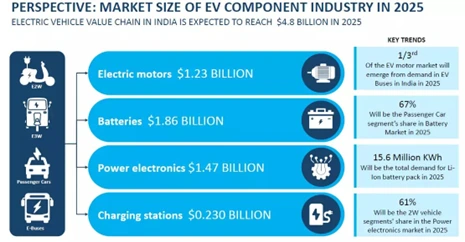
India’s EV Revolution:
- Need:
- At the COP26 to the UNFCCC (held in Glasgow, UK, in 2021), the Indian PM presented to the world Panchamrit of India’s climate action plan.
- The Panchamrit/ the 5 nectar elements included:
- Increasing non-fossil fuel capacity by 500 GW by 2030.
- 50% of its energy requirements will come from renewable energy by 2030.
- Reduction of total projected carbon emissions by 1 billion tonnes from now to 2030.
- Reduction of the carbon intensity of the economy by 45% by 2030, over 2005 levels.
- Achieving the target of net zero emissions by 2070.
- Apart from this, the Indian PM also highlighted ‘Lifestyle for Environment’ (LiFE) - a global mission asserting the need to follow a sustainable lifestyle.
- Electric vehicles (EVs) can help India achieve its Panchamrit and LiFE goals by reducing emissions, improving energy security, etc.
- Steps taken by India:
- National Electric Mobility Mission Plan (NEMPP): The MHI launched the NEMMP 2020 in 2013 for deploying 5 to 7 million EVs in the country by 2020, lowering vehicular emissions by 1.3 to 1.5% by 2020, etc.
- The Faster Adoption and Manufacturing of Electric Vehicles (FAME) India Scheme:
- Launched as part of the NEMPP, the FAME India scheme has been implemented since 1st April 2015.
- Under this, subsidies are being given to promote manufacturing of electric and hybrid vehicle technology and to ensure sustainable growth of the same.
- Subsidies are meant to bring a price parity between vehicles that have electric motors and fossil fuel-run engines, thereby nudging buyers to go for the cleaner option.
- The first phase - FAME I, ran for four years until 2019. Under the FAME II (which ended on 31st March 2024), companies can -
- Offer a discount of up to 40% on the cost of locally manufactured vehicles and
- Claim it as a subsidy from the government.
- Production Linked Incentive (PLI) Scheme for the Automotive Sector: To boost domestic manufacturing of advanced automotive technology (AAT) products and attract investments in the automotive manufacturing value chain.
- PLI Scheme for National Programme on Advanced Chemistry Cell (ACC) Battery Storage: To enhance capabilities for the manufacture of ACC in India.
- Achievements of India’s EV revolution:
- The value of the Indian EV market in 2023 was US$2bn, and the projection by 2025 is US$7.1bn, with the domestic market achieving 10 million annual sales by 2030.
- Two-wheelers are driving this development, and they will make up 40-50% of all EVs sold in India by 2030.
- Over the past two years, the number of public chargers skyrocketed from a modest 1,800 to an impressive 16,347.
- EV revolution in India faces several challenges: Such as poor charging infrastructure, high cost (more expensive than conventional vehicles), battery lifespan, talent gap, lack of standardization (of charging infra and techs) and regulatory challenges (like unclear guidelines).
About the PM E-DRIVE Scheme:
- Objectives:
- The scheme seeks to accelerate the adoption of electric vehicles in India by offering upfront incentives for their purchase and facilitating the creation of necessary charging infrastructure.
- Its goal is to reduce the environmental impact of transportation and improve air quality through the promotion of EVs, mass public transportation, and advanced EV technologies.
- Key highlights:
- Subsidies and demand incentives: The scheme allocates Rs 3,679 crore to incentivise the purchase of electric two-wheelers (e-2Ws), three-wheelers (e-3Ws), electric ambulances, trucks, and other emerging EV categories.
- E-Vouchers for EV buyers:
- Buyers of electric vehicles will be issued an e-voucher under the scheme to avail demand incentives.
- The e-voucher will be Aadhaar-authenticated and sent to the buyer's registered mobile number after the purchase.
- E-Ambulance deployment: A budget of Rs 500 crore has been allocated to deploy electric ambulances. This new initiative aims to provide comfortable and environmentally friendly patient transport.
- E-Buses for public transport: Rs 4,391 crore has been earmarked for the procurement of 14,028 e-buses by State Transport Undertakings (STUs) and public transport agencies.
- Incentives for E-Trucks: Rs 500 crore has been allocated to promote the deployment of e-trucks, a major contributor to air pollution.
- Charging infrastructure: To address range anxiety and support the growth of electric vehicles, Rs 2,000 crore will be used to install public charging stations (EVPCS) in cities with high EV penetration and along selected highways.
- Modernisation of testing facilities: An additional Rs 780 crore has been approved to modernize MHI’s test agencies, ensuring they are equipped to handle new and emerging green mobility technologies.
|
UPSC Civil Services Examination, Previous Year Questions (PYQs) Mains Q:1 How is efficient and affordable urban mass transport key to the rapid economic development in India? (2019) |
Source: IE
Share the article
Edukemy’s Current Affairs Quiz is published with multiple choice questions for UPSC exams
MCQ
Get Latest Updates on Offers, Event dates, and free Mentorship sessions.

Get in touch with our Expert Academic Counsellors 👋
FAQs
UPSC Daily Current Affairs focuses on learning current events on a daily basis. An aspirant needs to study regular and updated information about current events, news, and relevant topics that are important for UPSC aspirants. It covers national and international affairs, government policies, socio-economic issues, science and technology advancements, and more.
UPSC Daily Current Affairs provides aspirants with a concise and comprehensive overview of the latest happenings and developments across various fields. It helps aspirants stay updated with current affairs and provides them with valuable insights and analysis, which are essential for answering questions in the UPSC examinations. It enhances their knowledge, analytical skills, and ability to connect current affairs with the UPSC syllabus.
UPSC Daily Current Affairs covers a wide range of topics, including politics, economics, science and technology, environment, social issues, governance, international relations, and more. It offers news summaries, in-depth analyses, editorials, opinion pieces, and relevant study materials. It also provides practice questions and quizzes to help aspirants test their understanding of current affairs.
Edukemy's UPSC Daily Current Affairs can be accessed through:
- UPSC Daily Current Affairs can be accessed through Current Affairs tab at the top of the Main Page of Edukemy.
- Edukemy Mobile app: The Daily Current Affairs can also be access through Edukemy Mobile App.
- Social media: Follow Edukemy’s official social media accounts or pages that provide UPSC Daily Current Affairs updates, including Facebook, Twitter, or Telegram channels.

